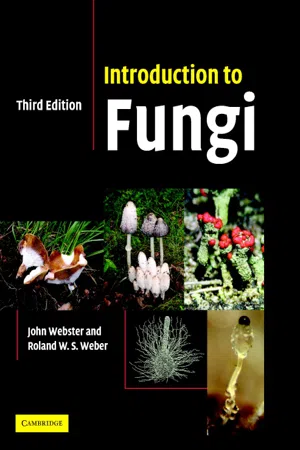Introduction to Fungi
About this book
This new edition of the universally acclaimed and widely-used textbook on fungal biology has been completely re-written, drawing directly on the authors' research and teaching experience. The text takes account of the rapid and exciting progress that has been made in the taxonomy, cell and molecular biology, biochemistry, pathology and ecology of the fungi. Features of taxonomic relevance are integrated with natural functions, including their relevance to human affairs. Special emphasis is placed on the biology and control of human and plant pathogens, providing a vital link between fundamental and applied mycology. The book is richly illustrated throughout with specially prepared drawings and photographs, based on living material. Illustrated life-cycles are provided, and technical terms are clearly explained. Extensive reference is made to recent literature and developments, and the emphasis throughout is on whole-organism biology from an integrated, multidisciplinary perspective.
Frequently asked questions
- Essential is ideal for learners and professionals who enjoy exploring a wide range of subjects. Access the Essential Library with 800,000+ trusted titles and best-sellers across business, personal growth, and the humanities. Includes unlimited reading time and Standard Read Aloud voice.
- Complete: Perfect for advanced learners and researchers needing full, unrestricted access. Unlock 1.4M+ books across hundreds of subjects, including academic and specialized titles. The Complete Plan also includes advanced features like Premium Read Aloud and Research Assistant.
Please note we cannot support devices running on iOS 13 and Android 7 or earlier. Learn more about using the app.
Information
Table of contents
- Cover
- Half-title
- Title
- Copyright
- Dedication
- Contents
- Preface to the first edition
- Preface to the second edition
- Preface to the third edition
- Acknowledgements
- 1 Introduction
- 2 Protozoa: Myxomycota (slimemoulds)
- 3 Protozoa: Plasmodiophoromycota
- 4 Straminipila: minor fungal phyla
- 5 Straminipila: Oomycota
- 6 Chytridiomycota
- 7 Zygomycota
- 8 Ascomycota (ascomycetes)
- 9 Archiascomycetes
- 10 Hemiascomycetes
- 11 Plectomycetes
- 12 Hymenoascomycetes: Pyrenomycetes
- 13 Hymenoascomycetes: Erysiphales
- 14 Hymenoascomycetes: Pezizales (operculate discomycetes)
- 15 Hymenoascomycetes: Helotiales (inoperculate discomycetes)
- 16 Lichenized fungi (chiefly Hymenoascomycetes: Lecanorales)
- 17 Loculoascomycetes
- 18 Basidiomycota
- 19 Homobasidiomycetes
- 20 Homobasidiomycetes: gasteromycetes
- 21 Heterobasidiomycetes
- 22 Urediniomycetes:Uredinales (rust fungi)
- 23 Ustilaginomycetes: smut fungi and their allies
- 24 Basidiomycete yeasts
- 25 Anamorphic fungi (nematophagous and aquatic forms)
- References
- Index
